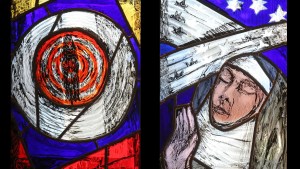“Then I saw as it were a great multitude of very bright living lamps, which received fiery brilliance and acquired an unclouded splendor,” writes St. Hildegard of Bingen. This is how she begins her description of the creation of the world in Scivias, which is a collection of illustrations and writings about visions she’d recently experienced. I begin with this quote because some of that fiery brilliance she sees in the creation of the universe also shines through in the creativity of Scivias. Written in the 12th century, there’s nothing quite like it.
That’s because there was no one quite like St. Hildegard. A medieval German abbess, visionary mystic, poet, musical composer, dabbler in herbs and medicines, inventor of her own private language, and possibly a visual artist, she was proclaimed a Doctor of the Church in 2012. Today, she is revered as the patron saint of musicians and writers.
A visionary book
The Scivias, short for Scito vias Domini meaning “know the ways of the Lord,” is a record of the visions she received as she entered her 43rd year of age. She’d been having visions since she was a child, which caused great distress as they grew in strength. While they lasted, she was immobilized in a trance-like state and felt them as physically painful. They were so intense that, when she describes them, she does so in the third person, writing that she “suffers in her inmost being and in the veins of her flesh.” It seems as though the pain, or maybe the vision, carried her momentarily away from herself.
The resulting descriptions of what she saw are powerful and poetic. Beauty is wrenched from the pain (or maybe it’s the beauty that caused the pain). In the beginning of the book is an illustration of Hildegard in the midst of receiving her first vision.

Editor’s note: View more of St. Hildegard’s art by clicking on the PHOTO GALLERY at the end of this article.
Tongues of fire are descending from Heaven into her mind. She writes under the miraculous illumination, using her talent as a writer to communicate something of it to us. Describing this scene, she writes, “I saw a great splendor in which resounded a voice from Heaven, saying to me, ‘O fragile human, ashes of ashes, and filth of filth! Say and write what you see and hear.” What follows are a number of visions full of symbolic images and strange sights.
A wild and untamed mystic
For instance, she writes that her vision on creation was brought to her in the following manner; “A pit of great breadth and depth appeared, with a mouth like the mouth of a well, emitting fiery smoke with great stench, from which a loathsome cloud spread out and touched a deceitful, vein-shaped form. And, in a region of brightness, it blew upon a white cloud that had come forth from a beautiful human form and contained within itself many and many stars…”
Descriptions of such force are reminiscent of prophetic visionaries such as Daniel and St. John. She’s like an Old Testament prophet, confounding and endlessly fascinating. It’s too much for words.
In order to capture more of the fullness of the visions, the community of religious sisters who lived with St. Hildegard decided to accompany the words with images. Scholars are unsure of when the images were made or by whom, but it does seem probable that St. Hildegard gave approval to their inclusion in the manuscript and might have assisted with their composition. I’m not an expert in iconography, but to my eye the illustrations are eccentric. Like St. Hildegard, they’re wild and untamed. The medieval world was far more artistically daring and artistically creative than we suppose, but even as the great Gothic era was taking root, these pictures are noteworthy for their originality.

For instance, the second image, called “The Radiant,” (above left) depicts divine inspiration descending from Heaven like a river of fire. The flames engulf St. Hildegard’s head as she stands to speak the vision out loud. Everything around her is imprinted with stars.
The fourth image is called “The Universe,” (above right) and depicts the cosmos in a decidedly feminine way, surrounded by the word and fire of God, receptive of his grace. It’s a symbolic picture of birth and creativity.

Image ten (above left) depicts the Redeemer in a highly symbolic and abstract fashion. He is involved in the world’s incarnation, salvation, and glory. The two circles represent divine flames filling up an empty void and the six days of creation doing the same.
The eleventh image (above right) is an attempt to visualize the Trinity. Unlike the usual triangular-shaped examples, this one involves nested circles of light. The Trinitarian nature of the divine is hidden under His unity and the emergent figure is God as One.
These are just a few examples. There are 35 images total. Each one a testament to the creative insight of St. Hildegard. I could (and have) spent a lot more time looking at each one and thinking about their mysterious symbolism. The overwhelming sense I get from them is that she was a woman overwhelmed by the light. If, through her art, we can glimpse just a tiny bit of that glory, how wonderful that would be.
View the slideshow below to view more art depicting the visions of St. Hildegard of Bingen.
Or you can view the images on video below…




